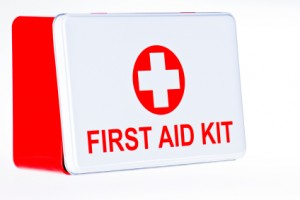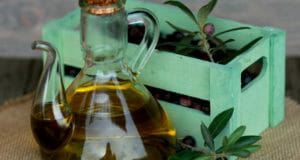Being able to meet the needs of your family for everyday things only works if you’re healthy and strong. So what do you do if you get hurt or sick and the nearest doctor is far away, or there aren’t any available doctors due to a major destructive event? Suppose you can’t drive, and no one can get to you in a hurry, what do you do then? Having a well-equipped first aid kit is essential and can mean the difference between life and death. You should consider what to include in a basic kit for an individual or small family and what can be used in an emergency.
 A good first aid kit should be prepared with the individuals and physical locale in mind. A couple in their twenties living in the mountains of Vermont would require a different combination of supplies than sixty-somethings in the high desert. So before you start assembling your personal items, make a list of the potential dangers and problems you could be faced with given your age and location. Many things will be the same wherever and whoever you are, but there will be some differences.
A good first aid kit should be prepared with the individuals and physical locale in mind. A couple in their twenties living in the mountains of Vermont would require a different combination of supplies than sixty-somethings in the high desert. So before you start assembling your personal items, make a list of the potential dangers and problems you could be faced with given your age and location. Many things will be the same wherever and whoever you are, but there will be some differences.
Another good point is to make sure you remember where you store the kit and ensure that it is someplace you can get to it quickly if you need it. If you’ve got a severely broken a leg and your kit is on the top shelf, it won’t do you much good. If you’re bleeding and feeling a little woozy, you might not feel up to looking for it, so make sure you those with you are familiar with the location of the kit.
Another consideration is the container to keep your first aid supplies in. Does it need to be portable so that you can take it hunting? Or will you keep it in a central location in your home? The container should be waterproof no matter its portability. Plastic bins with sealing tops are water resistant, see-through, and inexpensive. A leather or canvas sack can do the trick as well and is more portable. Once you have the container, what do you put in it? Let’s look at potential concerns and which items would be good to have.
Abrasions/Lacerations/Burns
The skin serves as a barrier to germs. Any interruption of the skin allows potential infection. It is helpful to have an antiseptic solution such as hydrogen peroxide for cleaning minor wounds. Hydrogen peroxide works by two mechanisms. First, the bubbling cleans the wound. The bubbling occurs because oxygen molecules are released. H2O2 becomes H2O (water) and O2 (an oxygen molecule). This also helps kill germs because they don’t live well in high oxygen levels. An antiseptic solution containing isopropyl or ethyl alcohol, benzalkonium chloride, clorhexidine, or iodine is another option, and you will find several varieties marketed under many brand names. After cleansing with your antiseptic, apply a triple antibiotic ointment such Neosporin or Polysporin. Then cover with a dry and sterile (or at least clean) bandage. Have a variety of sizes on hand, including a few large bandages. Look for non-stick varieties as well (Telfa), and include some rolled gauze for injuries not on a flat body surface.
Kit items: Antiseptic, antibiotic ointment, and bandages.
Emergency: Use drinking alcohol or liquor, wash with warm soap and water, and bandage with clean t-shirt strips.
Bleeding comes from two sources: veins and arteries. Venous bleeding is the most common and generally leaks or runs, while arterial bleeding spurts. Venous bleeding can be controlled with pressure. Use a bandage and apply pressure with your hand. Be careful not to dislodge the clot after it stops bleeding. If it starts again, reapply pressure. After the bleeding stops, treat like an abrasion with cleansing, antibiotic ointment, and bandage. Put a little more pressure on the bandage if necessary. If you have trouble controlling the bleeding, you may need stitches, staples or steri-strips. If an artery has been injured, you must go to the hospital. Until you can get there, keep firm pressure on the bleeding. In a situation like this, it would also be helpful to know how to apply a tourniquet.
Kit items: Sterile gauze, surgical tape, and elastic wrap (ACE bandage).
Emergency: Feminine pads work great to control and absorb bleeding. Scotch/duct tape, a belt, or rope can all be used for a tourniquet.
Poison Ivy
Contact dermatitis comes from direct contact with the oil or chemical you are allergic to. The rash will develop blisters that leak a clear fluid. You cannot spread the rash or give it to someone else by contact with leaking blisters. That is just the body’s reaction. However, you should make sure to wash the affected area well, because contact with the original substance still lingering on your skin can spread the rash. The rash will generally itch, but you shouldn’t scratch, as that can encourage bacterial infection. Use plain calamine lotion and wear socks on your hands. Benadryl (diphenhydramine) tablets can help the itching, as well as hydrocortisone cream. If there are large weeping blisters, a product called Domeboro’s solution helps dry them out.
Kit items: Calamine lotion, oral Benadryl, hydrocortisone cream, and Domeboro’s solution.
Emergency: Apply a paste of baking soda and water to the affected area. Witch hazel compresses can help itching and will dry blisters.
Fever/Pain
Every kit should contain something to lower temperature. While a slight elevation in temperature is one of the body’s defense mechanisms against infection, a temperature above 102, or any fever with shaking chills, never helped anyone. Nonsteroidal anti-inflammatories (Motrin, Advil, Aleve, and aspirin) have two good uses. They lower fever and reduce pain. In addition, as an anti-inflammatory, they actually treat underlying processes that can cause pain and fever like arthritis, sunburn, and bee stings. However, you should avoid these if you have an ulcer or take blood thinners. Acetaminophen (Tylenol) can lower fever and help mild pain but has no anti-inflammatory properties. It is the only painkiller listed here that is allowed during pregnancy though. Keep in mind that large quantities of acetaminophen can damage your liver.
Kit Items: Nonsteroidal anti-inflammatory or acetaminophen.
Emergency: Taking a room temperature bath or shower or applying cool compresses to the neck, groin, and underarms can help reduce fever and inflammation.
Broken Bones/Dislocations/Sprains
The idea is to immobilize a fracture or dislocation to prevent further injury and minimize pain. If the bone is broken, a splint may be necessary. Sprains should have a compressive dressing to control swelling and decrease motion, allowing healing and preventing further injury. Rolled cotton with an elastic bandage works well for most compression and immobilization needs. All of these injuries should also be elevated and ice applied initially.
Kit Items: Splinting material, rolled cotton, elastic wrap (ACE bandage), and instant cold packs.
Emergency: Wood or tree limbs can be used as a splint, with paper towels or feminine pads and duct tape used to immobilize the injury. A bag of frozen vegetables such as peas or corn can be used as an icepack in an emergency.
Allergy
Anyone can develop a life threatening allergic reaction at any time in their lives. Bee stings and nuts are the most common. For mild allergic reactions, you can usually treat it with oral Benadryl. However, allergic reactions often grow with each exposure. An individual mounts an antibody response to each exposure until they reach an anaphylactic reaction. Once this level is reached, a few itchy hives becomes a closed throat, generalized swelling, and death. It ranges from possibly never happening for some people (despite many exposures) to occurring after the first or second exposure to whatever it is they might be allergic to. Because of this, every first-aid kit should include an epi-pen. This is a single unit dose of adrenalin. It will cause your body to produce certain chemicals to help the allergic reaction. It is not used in place of an emergency hospital visit, only to buy you time. It should only be used for a life-threatening reaction, and you should still immediately call 911. Check with your doctor, as epi-pens can be difficult to obtain within certain states. An honest conversation with your doctor about your first aid concerns should net you some results.
Kit Items: Benadryl and an epi-pen.
Emergency: For mild allergic reactions, soaking a sting or hives in cold water can sometimes help relieve the swelling.
Now that you have the basic items in your first aid kit, consider your individual special needs. Here are a few items to think about.
AED: An automated external defibrillator is a self-contained monitor and heart defibrillator that is very user friendly. They are now found in most police cars, schools, arenas, restaurants, and office buildings. The cost is reasonable, and if you are over fifty or in a group environment, they are strongly recommended.
Blanket: Depending on the climate, you may need to keep an injured person warm. It can also be used to facilitate transportation of someone injured.
Breathing barrier: Particularly important in a group setting as performing breathing techniques during resuscitative efforts can cause concern for transmitting disease. Being a Good Samaritan should not endanger your own health.
Of course you can’t think of everything, but being prepared isn’t just a Boy Scout motto. Every kit should have a manual of first aid instructions. Read it before depositing it in your kit. An emergency is not the time to do research; use it for reference only. Learn CPR and make sure someone close to you knows how to do it. If you have known medical problems, take medications, or have a life-threatening allergy, be sure that information stays with you. Wear a medical alert bracelet or necklace. Put a medication or allergy list in your wallet, post it on the refrigerator, and put it in the glove box of your vehicle. You may not be able to give important information when you need to. Don’t wait to prepare for an emergency; you may not get a second chance.
The American Red Cross recommends a typical family of four include the following in their first aid kit:
- 2 absorbent compress dressings (5×9 inch)
- 25 adhesive bandages (assorted sizes)
- 1 roll adhesive cloth tape
- 5 antibiotic ointment packets
- 5 antiseptic wipes
- 2 packets aspirin
- 1 blanket
- 1 breathing barrier
- 1 instant cold pack
- 2 pair non-latex gloves
- 2 hydrocortisone packets
- 1 roller bandage (3 inches wide)
- 1 roller bandage (4 inches wide)
- 5 sterile gauze pads (3×3 inch)
- 5 sterile gauze pads (4×4 inch)
- Oral thermometer
- 2 triangular bandages
- Tweezers
- First aid instruction book
This is a STARTING POINT, and you should always be looking for a way to enhance your first aid resources at every opportunity. Look for ways to increase your availability to first aid products and materials: add a second or third setup, and consider another in your vehicle. And don’t forget to check with your doctor or health-care practitioner before treating (or making plans to treat) any illness or injury. First aid will at some point be a lifesaver, so plan accordingly.
©2011 Off the Grid News
 Off The Grid News Better Ideas For Off The Grid Living
Off The Grid News Better Ideas For Off The Grid Living





